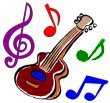Carnival and Mardi Gras Fun Activities |
| Formats | Info Page | WorkSheet | Quiz-Game | Review |
|
Hide all answers View all answers Print Try the Quiz
1. Carnival occurs before _______. • Shrovetide • Lent • Christmas Answer: Lent Lent is a period of fasting for forty days in preparation for Easter which, in the Christian calendar, is the biggest festival of the year. It is a time for the Christians to purify their sins and do penance by deprivation. There are 40 days of Lent between Ash Wednesday and Easter Sunday. After these 40 days, one celebrates Easter, the resurrection of Christ. During the period of Lent, the Church bans the consumption of meat. 2. The carnival begins on the day of _______. • Ascension • Thanksgiving • Epiphany Answer: Epiphany The carnival begins on the day of Epiphany, the first Sunday of January. Epiphany celebrates the visit of the Magi to infant Jesus. 3. Carnival celebrations are usually referred to as _______ Gras. • Mardi • Mercredi • Jeudi Answer: Mardi Mardi Gras (Mardi is a French word for Tuesday) day is the last day before Lent, when catholics give up certain foods like a meat and fat until Easter. Therefore, they feast the day before.
4. _______ is the last great day of the Carnival. • Lundi Gras • Lent • Mardi Gras Answer: Mardi Gras The end of the carnival is marked by Mardi Gras. This is the most important day of this period. 5. 'Mardi Gras' literally means '_______'. • Fat Tuesday • Fun Tuesday • Free Tuesday Answer: Fat Tuesday Mardi Gras, a French word, literally translates as 'Fat Tuesday'. Also called Shrove Tuesday, it is the day where people end up eating lot of fatty foods before the arrival of Lent, during which one abstains from eating meat and fat. 6. _______ is the ancient name of the carnival. • Candlemas • Pentecost • Shrovetide Answer: Shrovetide Before the appearance of the word 'carnival', the eve of Lent was called "Shrovetide". 7. Under the Roman Empire, there existed a big carnival called the _______ Carnival. • Jupiteralia • Saturnalia • Neptunalia Answer: Saturnalia Under the Roman Empire, there existed a big carnival called the Saturnalia Carnival. It was held between 17 and 25 December and marked the celebration of the winter solstice. 8. The _______ days are called 'fat days' . • Lent • Easter • Carnival Answer: Carnival Carnival is a time of rejoicing. The fat days are the days of the carnival for feasting, eating fat and enjoy before Lent which is a period of abstinence from meat or fat. 9. Traditionally _______ are eaten during Mardi Gras. • cakes • cookies • doughnuts Answer: doughnuts Mardi Gras, popularly, is the day when you eat the famous 'beignets de carnaval' (carnival doughnuts). 10. The word 'carnival' comes from the _______ language. • Latin • Spanish • German Answer: Latin The word 'carnival' means without meat. The word 'carnival' comes from the Latin word 'carne vale'. The word carne means meat and the word vale means to remove, signifying "farewell to meat", which one abstains from during the following period of Lent. 11. A carnival _______ is often organized during a carnival. • conference • parade • day Answer: parade A parade or a procession of floats and musical bands is often organized which takes place on the streets during a carnival or local festivals. 12. The people on the floats toss trinkets called '_______' to the spectators. • Balls • Throws • Toys Answer: Throws Trinkets called 'throws' are thrown at the crowd from the floats of the Carnival procession. 13. The typical 'Parade Throws' during a carnival parade are plastic cups, beads and _______. • doubloons • couploons • balloons Answer: doubloons 'Throws' or trinkets like plastic cups, beads, doubloons (aluminum or wooden dollar-sized coins embossed with a krewe logo) are thrown at the crowd from the floats of the Carnival procession. 14. Purple, _______ and gold are the official colors of Mardi Gras. • green • red • white Answer: green The colors purple, green and gold are the official colours representing Mardi Gras. 15. The three colors of Mardi Gras stand for _______, faith and power. • joy • justice • youth Answer: justice Purple represents justice, green represents faith and gold represents power. 16. At Mi-Karem red and black _______ reappear during the mini-carnival. • angels • birds • devils Answer: devils Mi-Karem or Mid-Lent, the time between the carnival and Easter, is a day of respite during Lent. The Carnival comes to life for one day. This is the day of red and black devils. 17. In many regions of the world, it is a tradition to burn an effigy of a _______ at the end of the carnival. • dragon • snowman • devil Answer: snowman At the end of the carnival, it is a tradition in many regions of the world to burn or bury an effigy of a snowman called Bonhomme Carnaval or Bonhomme Carnaval, the emblem of the carnival, at midnight. 18. The 'Grand Brilé Vaval' symbolizes the _______ of King Carnival, marking the end of the Carnival. • resurrection • birth • cremation Answer: cremation On the evening of Ash Wednesday (the day that ends the carnival), one sees the approaching end of the carnival called 'Grand brilé Vaval', which symbolizes the cremation of King Carnival called "Vaval," signalling the end of festivities. Everyone marches in black and white to mark the mourning of Vaval, and then begin the forty days of Lent.
|
 Carnival Quiz
Carnival Quiz 